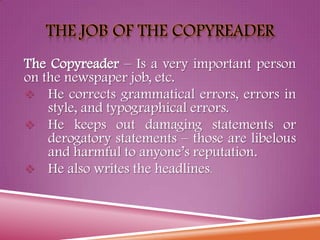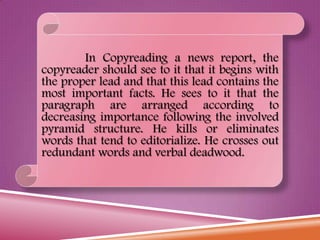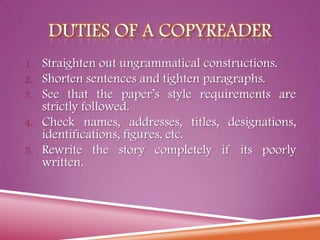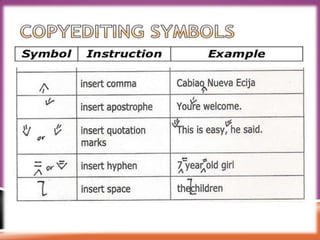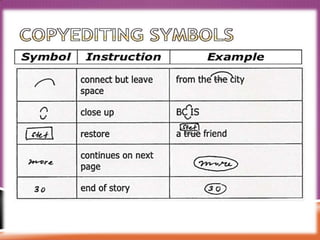Copyreading
- 2. WHAT TO KNOW IN COPYREADING?
- 3. COPYREADING ïThe process of arranging, correcting, and selecting the quality and type of a news. ïIt is also called copyediting.
- 4. COPY ïIs the typewritten materials sent to the linotypist to be typeset. It may be a news story, a feature article, an editorial, or a literary piece.
- 5. THE JOB OF THE COPYREADER The Copyreader â Is a very important person on the newspaper job, etc. ïķ He corrects grammatical errors, errors in style, and typographical errors. ïķ He keeps out damaging statements or derogatory statements â those are libelous and harmful to anyoneâs reputation. ïķ He also writes the headlines.
- 6. In Copyreading a news report, the copyreader should see to it that it begins with the proper lead and that this lead contains the most important facts. He sees to it that the paragraph are arranged according to decreasing importance following the involved pyramid structure. He kills or eliminates words that tend to editorialize. He crosses out redundant words and verbal deadwood.
- 7. Characteristics of a good copyreader : It has been said that a good copyreader must posses certain qualities. He or she must have the eye of an eagle and the touch of a butterfly.
- 8. PREPARING THE COPY In preparing the copy, the reporter should: 1. Use a typewriter or a computer â never submitting it in long hand. 2. Type on one side of the sheet only and double the space. 3. Begin his story (for news) about three inches from the top of the page.
- 9. 4. Indent deeply â at least five spaces â the beginning of each paragraph. 5. Identify on the first page the story with a slugline â the name of the paper, words identifying the story like âFireâ, or âStudent electionâ; the reporter and the date. 6. Type the word âMoreâ at the bottom of each page except the last, where he has to indicate the end of the story with a â30â or # mark.
- 10. DUTIES OF A COPYREADER 1. Straighten out ungrammatical constructions. 2. Shorten sentences and tighten paragraphs. 3. See that the paperâs style requirements are strictly followed. 4. Check names, addresses, titles, designations, identifications, figures, etc. 5. Rewrite the story completely if its poorly written.
- 11. 6. Rewrite the lead or the first few paragraphs whenever necessary, but must never tamper with the facts unless he is sure of his corrections. 7. Delete all opinion, speculations, and statements which are without attribution or sources. 8. Watch out for slanting or any attempt to present the story in a subtly biased way. 9. Watch out for libelous statements. 10. Recheck figures and totals.
- 12. 11. Cross out adjectives which tend to make a story sound over â written. 12. Cut a story to size or to the required length if need be. 13. Check attributions and see to it that they are properly identified. 14. Challenge facts, claims, or reports when they sound anomalous, illogical, and incredible. 15. Check sluglines and paging sequences. 16. Write headlines.
- 18. EDITED COPY
- 19. THANK YOU FOR LISTENING ! ï ACEBUCHE, NESTEVE F. BSED II â A





